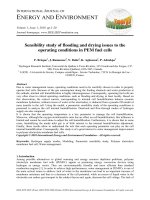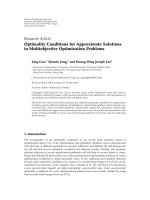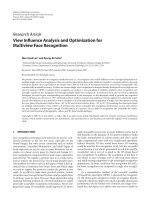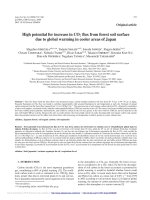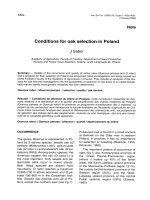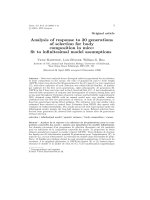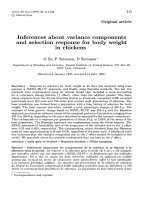Response surface optimization for operating conditions in comprehensive sagd performance
Bạn đang xem bản rút gọn của tài liệu. Xem và tải ngay bản đầy đủ của tài liệu tại đây (3.98 MB, 114 trang )
Response Surface Optimization for
Operating Conditions in Comprehensive
SAGD Performance
NGUYEN XUAN HUY
The Graduate School of
Sejong University
Department of Energy and Mineral Resources Engineering
Response Surface Optimization for
Operating Conditions in Comprehensive
SAGD Performance
NGUYEN XUAN HUY
A Doctoral Thesis Submitted to the Department of Energy and Mineral
Resources Engineering and Graduate School of Sejong University
in partial fulfillment of the requirements
for the degree of Doctor of Engineering
May 2012
Approved by
Prof. Wisup Bae
Major Advisor
This certifies that the dissertation of Nguyen Xuan Huy
is approved.
Professor Taewoong Chung
Professor Wisup Bae
Professor Jonggeun Choi
Professor Kyungiun Jun
Professor Myung Jin Nam
The Graduate School of
Sejong University
May, 2012
Dedication
To
my parents and my younger sister and brother
Acknowledgment
My name is Huy Xuan Nguyen. I have over 10 years experience in the area of
petroleum geology and reservoir simulation in the oil and gas industry. I hold B.Eng. (2001)
and M.Eng. (2004) degrees in petroleum engineering and MBA degree (2008) in petroleum
economic from Ho Chi Minh University of Technology as considered the top university with
the high quality education in Vietnam. I have positioned the lecturer in teaching
undergraduate and science research at Faculty of Geology and Petroleum Engineering, Ho
Chi Minh City University of Technology since 2003. In 2009, I received the PhD scholarship
program in petroleum engineering from Sejong University under the supervisor of Professor
Wisup Bae.
Currently, my research interested in the section of petroleum economic management,
chemical EOR flooding, thermal oil recovery processes, particularly the oil recovery
improvement on SAGD process and the application innovative technologies to exploit the
unconventional resources based on electromagnetic heating, nuclear energy, single-well
SAGD, and operation optimization. I am author and coauthor of more than 20 technical
papers including SCI Journals, SPE, AAPG and international conferences around the world.
I would like to express my special appreciation to my supervisor Prof..Wisup Bae for
kind support and academic valuable suggestions throughout my work.
I also would like to express my sincere thank to the members of petroleum lab in
Sejong University Ngoc T. B Nguyen, Cuong Dang, Taemoon Chung, Tho N. Tu, and Danh
H. Nguyen for their generosity and suggestions. Their assistances are essential in performing
my research successfully and have made my studying life here more enjoyable and priceless.
By the fact of completing this thesis, I am immensely indebted to my parents, Nguyen
Xuan Lang and Tran Thi Tuyet Nhung younger sister and brother. They have encouraged and
nurtured in the development of my personality and support any decision and future career
direction.
Last but not least, I would like to express my sincere thank to my friends in
Vietnamese Students Association in Korea for their generosity and help during study time in
Korea.
Abstract
The steam assisted gravity drainage (SAGD) process has proven to be an effective
thermal recovery method for heavy oil and bitumen production. However, there has been
much dispute over the question of technical and economical risks. The technical efficiency of
the SAGD process depends on two important factors: reservoir properties and operating
conditions. The SAGD performance was investigated based on the variables of reservoir
properties such as thickness, porosity, permeability, oil saturation, viscosity, rock thermal
conductivity, along with operating variables as including preheating, injector/producer
spacing, injection pressure, steam injection rate and subcool temperature. In addition, the
economic risks associate to the cost of initial investment for building ground facilities,
operating costs, and the uncertainties of oil and gas prices. The integration of economic and
technical aspects for SAGD performance plays an important role in field operation. Main
problems to solve are how to design optimal operating conditions for a reasonable steam
requirement with certain injection pressure to maximize economic feasibility under reservoir
conditions.
Recently, some innovative techniques based on the background SAGD operation have
been applied such as conventional SAGD, Fast-SAGD, Hybrid SAGD, FA-SAGD. Most
previous literatures implemented sensitivity analysis and optimization of SAGD performance
by classical methods based on numerical simulations lead to a lack of confidence level and
ignored interactions effects between considered parameters, which may cause low efficiency
issues in a field operation. In addition, the SAGD economic models have not fully
information with limited consideration on few factors. These restrictions can be avoided by
the application design of experiment and response surface methodology to determine the
optimal operating conditions for the production prediction. Then, discontinuous SAGD
technique was operated to control the amount of injected steam at several specific injection
time intervals.
The results showed that the effect of reservoir parameters on SAGD performance is
the most important with order ranking as porosity, thickness, oil saturation, permeability,
viscosity, and then interaction factors of reservoir properties. Subsequent to injection pressure
and steam injection rate have a greatest effect in operational parameters. The results of this
study showed uncertainties ranking of reservoir and operational parameters are a target for
best choice on oil sand projects.
The new concept of the discontinuous SAGD process is applied to three major
formations of Alberta’s oil sands after optimal operation conditions based on response
surface methodology. The results showed that both oil recovery factor and economic profit
are much higher than other techniques of Fast-SAGD and conventional SAGD process,
especially the effective at deeper burial reservoirs of Clearwater and Bluesky formations.
Moreover, amount of steam injection rate and cumulative steam oil ratio (CSOR) reduced
significantly to cause lower operating costs as steam cost, led to increase NPV as well as
minimal environmental damages. This study will help to improve heavy oil recovery with the
minimal environmental damages and with lower production cost.
Table of Contents
Abstract .................................................................................................................................
List of Figures........................................................................................................................
List of Tables .........................................................................................................................
List of Nomenclature and Abbreviations .............................................................................
Chapter 1 Introduction……………………………………………………………………..1
1.1 Overview......................................................................................................................... 1
1.2 Description of the problems……………………………………………………………….2
1.3 Research objective and methodology…………………………………………………….. 3
1.4 Literature Review…………………………………………………………………………4
1.4.1 Geological characteristics in Alberta oil sands………………………………………….4
1.4.2 Athabasca oil sands…………………………………………………………………..…6
1.4.3 Cold Lake oil sands…………………………………………………………………..…7
1.4.4 Peace River oil sands……………………………………………………………………8
1.4.5 Lloydminster oil sands………………………………………………………………….8
1.4.6 A review of the development of thermal recovery technology………………………….9
1.4.6.1 SAGD technique……………………………………………………………………...9
1.4.6.2 Fast-SAGD technique…………………………………………………………….…11
1.4.6.3 Hybrid SAGD technique…………………………………………………………….13
1.5 The control of operating parameters under reservoir conditions………………………14
Chapter 2. Design of Experiment and Response Surface Methodology
2.1 Response surface methodology…………………………………………………………18
2.2 Two-Level Factorial Designs…………………………………………………………20
2.3 Two-Level Fractional Factorial Designs………………………………………………20
2.4 Central Composite Design (CCD)…………………………………………………..…21
2.5 Box-Behnken design………………………………………………………………..…22
2.6. Face Centred Central Composite Design (FCCD)……………………………………24
2.7. D-optimal design……………………………………………………………………24
2.8. Model adequacy checking..…………………………………………………………25
2.8.1 Test for significant of regression…………………………………………………26
2.8.2. Residual analysis………………………………………………………………….28
2.8.3 Scaling Residuals………………………………………………………………..29
2.8.4 Lack of Fit Test……………………………………………………………………31
2.9 Optimization….……………………………………………………………………..32
Chapter 3: Effects of Reservoir Properties and Operating Conditions on SAGD
Performance
3.1 The application D-Optimal design and RMS for sensitivity analysis………………….36
3.2 Effects of reservoir variables……………………………………………………………38
3.2.1 Porosity…………………………………………………………………………….…38
3.2.2 Thickness..…………………………………………………………………….……39
3.2.3 Oil saturation….……………………………………………………………………39
3.2.4. Permeability….……………………………………………………………………40
3.2.5 Viscosity…….…………………………………………………………………..…40
3.2.6 Rock thermal conductivity………………………………………………………..41
3.3 Effect of operational parameters………………………………………………….…41
3.3.1 Vertical well spacing (IPS)………………………………………………………..41
3.3.2 Injection Pressure……………………………………………………………………42
3.3.3 Steam Injection Rate…………….………………………………………………..42
3.3.4 Subcool Temperature………..………………………………………………..…42
3.4 Conclusions…………….…………………………………………………..………43
Chapter 4 : Response Surface Optimization for Operating Conditions in Three Major
Reservoirs of Alberta’s Oil Sand.
4.1 Athabasca oilsands……………………………………………………………………52
4.1.1 Application of central composite face-centred design for optimizing the operating
conditions….………………………………………………………………………52
4.1.2 Effect of operating parameters on the NPV.…………………………………………55
4.1.3 Optimization of operating conditions by response surface methodology……………56
4.1.4 Verification of predictive model…………………………………………………..…57
4.1.5 Comparison and the best choice for operating conditions in conventional SAGD process
4.1.6 Optimization for Fast-SAGD performance………………………………………….58
4.1.7 Optimization for discontinuous SAGD performance………………………………..60
4.2 Cold Lake oilsands……………………………………………………………………64
4.2.1Application of Box-Behnken design for optimizing the operating conditions….64
4.2.2 Effect of operating parameters on the NPV…………………………………………66
4.2.3 Optimization of operating conditions by response surface methodology…………..68
4.2.4 Verification of predictive model…………………………………………………….69
4.2.5 Comparison and the best choice for operating conditions in conventional SAGD
process………………………………………………………….......................................69
4.2.6 Optimization for Fast-SAGD performance………………………………………..70
4.2.7 Optimization for discontinuous SAGD performance………………………………..72
4.3 Peace River oilsands……………………………………………………………………77
4.3.1Application of central composite face-centred design for optimizing the operating…..77
conditions
4.3.2 Effect of operating parameters on the NPV…………………………………………79
4.3.3 Optimization of operating conditions by response surface methodology……………81
4.3.4 Verification of predictive model………………………………………………………81
4.3.5 Comparison and the best choice for operating conditions in conventional SAGD process
4.3.6 Optimization for Fast-SAGD performance…………………………………………….82
4.3.7 Optimization for discontinuous SAGD
performance……………………………………85
Chapter 5: Summary, Conclusions and Recommendations…………………………90
5.1. Summary ……………………………………………………………………………90
5.2 Conclusions…………………………………………………………………………91
5.3 Recommendations for future work………………………………………………….93
References
List of Figures
1.1. The regions of Albertan Oil Sands, cross section and stratigraphic succession, 2008,
AAPG.
1.2. Typical viscosities of bitumen in three majors oil sands
1.3. The production mechanism of SAGD horizontal well pairs (NEB, 2004)
1.4. Operation of injection and production in SAGD process (NEB, 2004)
1.5. The Fast – SAGD process
1.6. Arrangement of wells in HSAGD and Fast-SAGD system
2.1. Sample experimental designs (a) 22 factorial design, (b) 3 2 factorial design, (c) central
composite design and (d) face-centred cubic design
2.2. The points distribution of a Central Composite Design
2.3 Box- Behnken design
2.4. Geometry of Face Centred Central Composite for three variables.
2.5. Normal probability plot of residuals
2.6. The desirability curve for the goal as minimum
2.7. The desirability curve for the goal as maximum
2.8. The desirability curve for the goal as maximum
2.9. The desirability curve for the goal as Within range
3.1. The order ranking of variables
3.2. Normal probability plot of NPV response
3.3. Effects of reservoir and operational parameters on NPV responses
4.1. The order ranking of factors affecting on NPV, Athabasca oilsands
4.2 Effects of operating conditions on NPV, Athabasca oilsands
4.3 Response surface plots, Athabasca oilsands
4.4. Cumulative oil in Athabasca oil sands
4.5. Cumulative SOR in Athabasca oil sands
4.6. Oil rates in Athabasca oil sands
4.7. The order ranking of factors affecting on NPV, Cold Lake Oilsands
4.8. Effects of operating conditions on NPV, Cold Lake oilsands
4.9. Surface response map, Cold Lake oilsands
4.10. Optimal operating conditions of CSS well in Fast SAGD, Cold Lake oil sands
4.11. Response Surface plots in Fast-SAGD, Cold Lake oil sands
4.12. Cumulative oil in Cold Lake
4.13. Cumulative steam oil rate in Cold Lake
4.14. Oil rate in Cold Lake
4.15. The order ranking of factors affecting on NPV, Peace River oilsands
4.16. Effects of operating conditions on NPV, Peace River oilsands
4.17. Surface response map in SAGD process, Peace River oilsands
4.18. Optimal operating conditions of CSS well in Fast SAGD, Peace River oil sands
4.19. Response Surface plots in Fast-SAGD, Peace River oilsands
4.20. Cumulative Oil in Peace River Oilsands
4.21. Cumulative SOR in Peace River Oilsands
4.22. Oil rates in Peace River Oilsands
List of Tables
1.1 Geological features of Cold Lake in Alberta (National Energy Board, 2000)
2.1. Coded factor levels for Box-Behnken designs for optimizations involving four and five
factors
2.2 Comparison of efficiency of central composite design and Box-Behnken design
3.1. Variables and D-optimal design levels
3.2. The D-optimal design with 10 independent variables
3.3. ANOVA for response surface quadratic model
3.4. Regression coefficients of the predicted quadratic polynomial model.e surface quadratic
model
4.1. Reservoir properties
4.2. Variables and CCF design levels, Athabasca oilsands
4.3. The CCF design with four independent variables, Athabasca oilsands
4.4. ANOVA for Athabasca oilsands
4.5. Estimated regression coefficients for NPV by using coded units
4.6. Optimization of operating conditions in conventional SAGD process, Athabasca Oilsands
4.7. Optimization of operating conditions in Fast SAGD process, Athabasca Oilsands
4.8. Steam injection mode in discontinuous SAGD process in Athabasca oilsands
4.9 Variables and experimental design levels, Cold Lake oilsands
4.10 Box-Benhken design with four independent variables, Cold Lake oilsands
4.11. ANOVA for Cold Lake Oilsands
4.12. Estimated regression coefficients for NPV by using coded units
4.13.Optimization of operating conditions in conventional SAGD process,
Cold Lake
Oilsands
4.14. Variables and experimental design levels in CSS well, Cold Lake
4.15. Full factorial design of CSS well in Fast-SAGD
4.16. Estimated regression coefficients for CSS well, Cold Lake oilsands
4.17. Optimal operating condition of CSS well, Cold Lake oilsands
4.18. Optimization of operating conditions in Fast SAGD processes, Cold Lake Oil sands
4.19. Steam injection mode in discontinuous SAGD process in Cold Lake oilsands
4.20. Variables and experimental design levels Peace oilsands
4.21. The CCF design with four independent variables, Peace River oilsands
4.22. ANOVA for Peace River oilsands
4.23. Estimated regression coefficients for NPV by using coded units, Peace River oilsands
4.24. Optimization of operating conditions in conventional SAGD process, Peace River Oilsands
4.25. Variables and experimental design levels in CSS well, Peace River Oilsands
4.26. Full Factorial design of CSS well in Fast-SAGD
4.27. Estimated regression coefficients for NPV by using coded units, Peace River oilsands
4.28. Optimal operating condition of CSS well
4.29. Optimization of operating conditions in Fast SAGD processes, Peace River Oilsands
4.30. Steam injection mode in discontinuous SAGD process in Peace River Oilsands
List of Nomenclature and Abbreviations
CMG
Computer Modeling Group
CSS
Cyclic Steam Stimulation
CSOR
Cumulative Steam-Oil-Ratio
DOE
Design of Experiment
dSAGD
Discontinuous SAGD
FA-SAGD
Foam-assist SAGD
Kv/Kh
Vertical permeability/ Horizontal permeability
IP
Injection Pressure
IPS
Injector Producer spacing
MCS
Monte Carlo Simulation
MSIR
Maximum Steam Injection Rate
NPV
Net Present Value
PERM
Permeability
Poro
Porosity
RSM
Response Surface Methodology
SAGD
Steam Assisted Gravity Drainage Process
Strap
Subcool Temperature
SOR
Steam-Oil-Ratio
THCONR
Rock thermal conductivity, 105 kJ/m day C
VW
Vertical Well
HW
Horizontal Well
WPS
Well Pattern Spacing
Visc
Viscosity
CHAPTER 1
Introduction
Oil demand for economic development around the world is increasing rapidly. For
conventional oil, the production are reaching up the peak in mature field and trending to decline in
the near future. In front of this perspective, a potential unconventional resources of heavy oil and
bitumen interested deeply in Western Canada and Venezuela as world’s the largest reserves. Despite
over 30 years of commercial exploitation in unconventional resources, many challenges related to
technical and economic issues are facing for enhancing oil recovery factor. Because of extremely
high viscosity, several thermal recovery methods conducted to reduce its that oil flow can easily
move to producer. The steam-assisted gravity drainage (SAGD) process is applied common at
present for heavy oil and bitumen production utilizing two parallel horizontal wells, one above the
other. Oil recovery factor can achieve the range of 45-55% BIOP. With available current
technology, the economic efficiency is considered as an important decision to the appropriate choice
of operating condition in oil sand projects
1.1 Overview
The vast reserves of oil sands deposits are trapped in shallow Alberta’s oil sands, with an
estimated 1.7 trillion bbls of bitumen in place, as the third-largest proven crude oil reserve in the
world, next to Saudi Arabia and Venezuela. The estimated remaining recoverable from bitumen
resource is only about 10% with current techniques.
The conventional SAGD process is applied the most popular as technically effective of thermal
recovery method (Butler, 2001). By using two horizontal wells are located at the bottom of
reservoir, one injector located above the oil producer at short vertical distance, the heat from steam
1
injected of injector can transfer upward to the top and sideways of reservoir effectively and
production recovery mechanism based on the gravity driving force affecting on heated bitumen.
The Fast-SAGD process comprised two full SAGD well pairs and two CSS wells (Polikar,
2000), uses offset wells, which are placed horizontally about 50m away from the SAGD producer
and each offset well. These offset wells are operated alternatively as injector and producer. When
the steam chamber reaches up the top reservoir after operating SAGD well pairs, the CSS operation
is started at the first offset well. The CSS operation at other offset wells will be started later with a
certain schedule after the CSS operation at the first offset well.
Discontinuous SAGD technology (dSAGD) is new concept based on the background of
conventional SAGD process (Huy, 2012). In SAGD conventional technique, the injectors are
continuously injecting steam into reservoir and continuously producing from the producers. Instead
of continuing injected steam, injectors are operated the following Cyclic Steam Stimulation mode
with certain difference standby time intervals as called discontinuous SAGD technique, while
producers still keep working after preheating connection spacing between the wells.
1.2 Description of the problems
The SAGD process is an effective thermal recovery method for heavy oil and bitumen
production utilizing two parallel horizontal wells, one injector located above the oil producer at
short vertical distance. However, the high uncertainties of reservoir properties and operating
conditions affected significant to oil recovery factor and profit. Hence, both reservoir properties and
operating parameters must be investigated clearly for making decision the best choice of oil sands
project as well as operating conditions.
Polikar (2000), Gong (2002) and Shin (2007) have conducted the optimization of SAGD process
by classical methods based on their numerical simulations and experiments. However, there is a
lack of confidence level in the optimized conditions because they didn’t determine the significance
level of operational parameters and ignored interactions effects between considered parameters,
2
which may lead to low efficiency issues in a field operation. These limitations of the classical
method can be avoided by application design of experiment (DOE) and response surface
methodology (RSM) that involves statistical design of experiments in which all factors are varied
together over a set of experimental runs.
In addition, there has been much dispute over the question of economic efficiency due to high
capital investment, operating costs as steam cost, and the uncertainties of oil and gas prices. The
economic models in previous studies were not comprehensive enough and backward with limited
consideration on only three factors such as steam cost, low bitumen price and discount rate. That
approach could significantly reduce the accuracy of economic evaluations and make it very difficult
to predict the best selection of process performance. The integration of economic and technical
aspects for SAGD operation plays an important role for success in field operation.
Recently, some innovative techniques based on the background SAGD operation have been
applied such as conventional SAGD, Fast-SAGD, Hybrid SAGD, FA-SAGD. However, in
practical, an increase oil recovery is not remarkable and, so using conventional SAGD process is
still as common approach. In this study, the author established a new operating process based on the
background of SAGD called as discontinuous SAGD (dSAGD). The injectors are operated at
specific difference time intervals in dSAGD. The result proved that the dSAGD performance
worked better than others were, the best way to maximize oil recovery, and minimal steam
requirements and heat loss.
1.3 Reaseach objective and methodology
This study describes the application of DOE and RSM to investigate the effect level of reservoir
properties and operating parameters on the oil recovery factor and net present value. Based on the
economic perspective, the optimization of operating parameters is identified under uncertainties of
reservoir conditions in three oil sands areas in Alberta: Athabasca, Cold Lake, and Peace River
areas. It was aimed to mitigate the risk of incomprehensive economic assessment on the process
3
operation. The study started with the using of DOE to screen the independent variables, and then
insignificant variables were excluded from model before developing the optimal design by response
surface methodology. The main objective need to do as follow:
1. The appropriate DOE types were selected to design the initial numerous samples. Reservoir
simulation scenarios were run by CMG’s Star to estimate the amount of oil recovery,
cumulative steam oil ratio (CSOR), produced water.
2. The economic model was built on Excel spreadsheet with the input parameters of reservoir
simulation results, the prices of oil and gas, capital costs, operating costs, non-gas cost and
discount rate of 10%.
3. Based on the net present value of analysis of variance in mathematic statistics, screening of
the reservoir and operating parameters are conducted to chose the most significant variables
and the sensitivity analysis. The RSM was employed to search for promising designs. The
uncertainties of NPV were evaluated, and the optimization of operating conditions in SAGD
and Fast-SAGD process was identified by building a surface response map.
4. Comparison and evaluation the effect of low and high injection pressure in SAGD and FastSAGD and propose the best solutions for operating options.
5. Subsequently, the most appropriate of these operating conditions are used for the
optimization dSAGD process to find the optimal the specific intervals of steam injection
time and standby time for the target of maximum oil recovery and minimum heated loss.
6. Among of the conventional SAGD, Fast-SAGD and dSAGD process, let compare and select
the best operating condition in three majors Alberta’s oil sands.
1.4 Literature review
1.4.1 Geological characteristics in Alberta oil sands
4
Canada’s resources of crude bitumen occur entirely within the province of Alberta and found in
sand and carbonate sedimentary formations in three regions defined as the Athabasca, Cold Lake
and Peace River Oil Sands Areas (Figure 1.1). These areas cover a minimum of 4.3 million
hectares, 729 thousand hectares and 976 thousand hectares respectively. The Athabasca formation
including Grand Rapids formation are buried at upper depth ranges of 200-400 m and lower depth
ranges of 270-470 m, Wabiskaw or McMurray formation are buried at Mineable depth ranges of 0120 m and In situ with depth ranges of 80-750 m. The Cold Lake formations including Grand
Rapids, Clearwater and McMurray are buried at depth ranges from 275-525 m, 370-500 m and 420600 m, respectively. The Athabasca oil sands are composed of approximately 70% sand and clay,
10% water and from 0 to 18% heavy oil or bitumen (Deutsch and McLennan, 2003).
As result of the estimation of Canadian oil sands reserves, 44% of Canadian oil production was
from oil sands, with an additional 18% being heavy crude oil, while light oil and condensate had
declined to 38% of the total. Oil sands represent as much as two-thirds of the world's total liquid
hydrocarbon resource, with at least 1.7 trillion barrels in the Canadian Oil Sands (assuming a 10%
recovery).
The characteristics of the bitumen and the reservoir properties of the oil sands is in large part a
function of the degree of biodegradation that took place. For the Peace River deposits, the oil
migrated the shortest distance and were subjected to only a moderate degree of biodegradation,
while for the Athabasca and the Cold Lake deposits, the migration distance was considerably farther
and therefore these deposits were subjected to a greater degree of biodegradation (NEB, 2000).
Some of the distinguishing characteristics of the three areas are:
+ The Peace River deposits contain bitumen in Mississippian carbonates, as well as in the
Permian and Cretaceous sandstones;
+ The Athabasca deposit has the largest areal extent and contains bitumen in the Devonian
carbonates and the Cretaceous sandstones; and,
5
+ The Cold Lake deposits contain bitumen only in the Cretaceous sandstones.
Figure 1.1. The regions of Albertan Oil Sands, cross section and stratigraphic succession, 2008,
AAPG
1.4.2 Athabasca oil sands
The Athabasca oil sands deposit is the largest petroleum accumulation in the world, covering an
area of about 46,000 km2. Most of the bitumen deposits are found within a single contiguous
reservoir, the lower cretaceous McMurray-Wabiscaw interval (Mossop, 1980). The McMurray
Formation lies over Devonian Formation, which is a layer of limestone, and is overlain by the
Wabiscaw Member of the Clearwater Formation. The Clearwater Formation is itself overlain by the
6
Grand Rapids Formation, which is dominated by sandstone (Hein, 2006). Clearwater shales provide
the cap rock for the reservoir.
McMurray formation is located in shallow depth regions (from 210 to 243m) with a pay zone
thickness of 40-100 meters and it averages about 30 meters of clean bitumen saturated sands (Hein,
2006). Initial oil and water saturation are 0.8 and 0.2, respectively. The absolutely permeability in
vertical direction is 2.5 Darcy, permeability ratio (kh/kv) equal 2 and the porosity is 0.25 – 0.35.
Average reservoir temperature is 10 0C, the bitumen is highly viscosity about 5,000,000 cP and
immobile in Fig 1.2.
1.4.3 Cold Lake oil sands
The Cold Lake oil sands deposit in northern Alberta contains over 40 x 10 9 of bitumen in place
(Beattie, 1991). There are three formations starting from the bottom to up: McMurray, Clearwater,
and Grand Rapids, belong to the members of the lower Cretaceous Mannville group. All three
formations contain bitumen, but the most laterally extensive and homogeneous deposits are in the
Clearwater formation (MossoP et al., 1980). Southward from Athabasca, the relatively deep-water
Clearwater shales change facies to a near-shore deltaic and foreshore/shoreface complex. The most
prospective targets include stacked distributary mouth bar sequences and non-marine fluvial and
high-energy tidal sand flats deposits (Gingras, 2004). Upper Grand Rapids deposition largely
represents brackish water near shore deposition overlying more normal marine conditions of the
lower Grand Rapids and upper Clearwater (Benyon and Pemberton 1992).
The Clearwater sands are unconsolidated, clean, well-sorted, fine to medium grained, and have
porosity between 14% and 35%. The absolute permeability ranges of 0.5 – 2.0 D and oil saturation
average of 70% PV. The in-situ viscosity of the bitumen is about 100,000 cp (Figure 1.2) and is
buried at depth ranges from 275-525 m, 370-500 m and 420-600 m, respectively. (Table 1.1). Steam
injection rates requires the high injection pressures to cause both localized fracturing and
widespread PV increases in the formation.
7
Table 1.1: Geological features of Cold Lake in Alberta (National Energy Board, 2000)
1.4.4 Peace River oil sands
Peace River oil sands contain over 155 billion barrels of bitumen in place, Northwestern
Alberta (Mark, 2007). The Bluesky reservoir was originally trapped as oil and contained by the
existence of top, basal and lateral seals. The Wilrich member is widespread marine shale that was
deposited during a significant marine transgression as an effective top seal to the reservoir, overlies
the Bluesky formation. The Bluesky formation uncomformably overlies the lower Cretaceous
Gething formation that comprises a series of interbedded sandstones, siltstones and mudstones
deposited in a delta plain environment. The Bluesky formation comprises a 20 – 30 meter thick sand
and reservoir depth of 400 – 750 m. Within the oil leg of the reservoir, hydrocarbon emplacement
appears to have halted or inhibited diagenesis relative to the underlying water-bearing sands in
which authigenic clays are much more abundant (Wightman et al., 1987).
1.4.5 Lloydminster Area
The Lloydminster area of Alberta and Saskatchewan has been the focal point of heavy oil
development for many years and geographically is the largest prospective area. Heavy oil
production is from the Mannville Group sediments, with the entire suite of Mannville Formation’s
being prospective targets.
8
